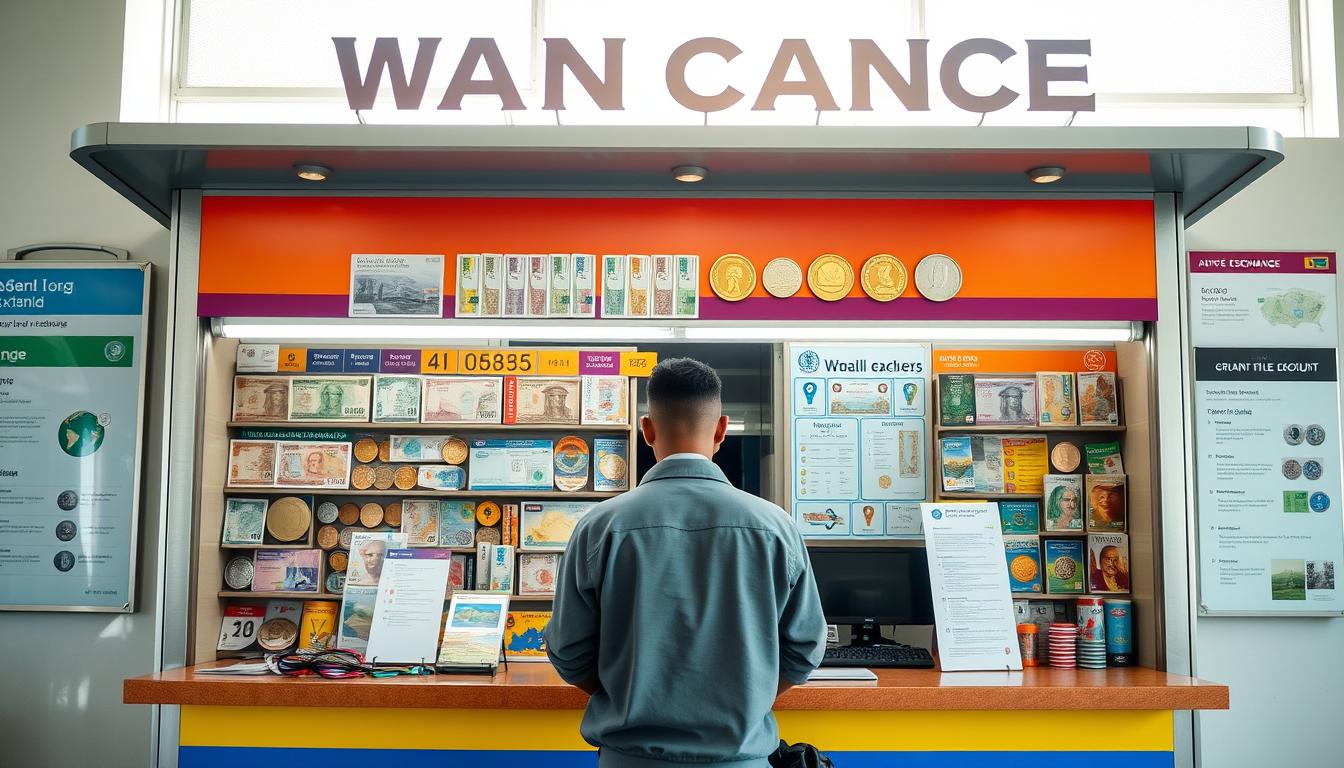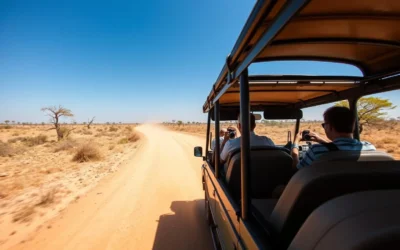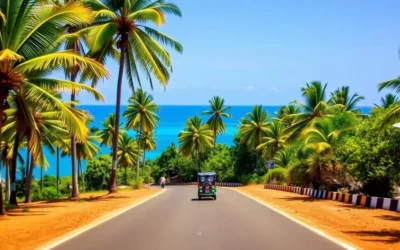✓ Accommodations✓ Flights✓ Rental Cars✓ Tours & Activities
Did you know that over 60% of travelers overspend on currency exchange fees during their trips? Managing your money wisely can make or break your travel experience. This guide is here to help you navigate the essentials of handling finances in a foreign country.
When planning your trip, understanding the mid-market exchange rate is crucial. It ensures you get the best value when swapping USD to LKR. Many travelers overlook this detail, leading to unnecessary expenses.
Cash remains vital in many places, but digital payments are also widely accepted. Knowing how to balance both can save you time and stress. This guide covers everything from historical insights to practical tips for a seamless experience.
By planning ahead, you’ll not only save money but also enjoy a smoother journey. Let’s dive into the details and make your next adventure unforgettable.
Understanding Sri Lanka’s Currency Landscape
The Sri Lankan rupee has a rich history that reflects the nation’s economic journey. Introduced in 1872, it replaced the British Indian rupee and became the official currency. Over the years, it has evolved, adapting to the country’s changing needs.
Today, the currency is available in both banknotes and coins. Banknotes come in denominations of 10, 20, 50, 100, 500, 1,000, 2,000, and 5,000 rupees. Coins include 1, 2, 5, and 10 cents, as well as 1, 2, 5, and 10 rupees. Each note features iconic landmarks, showcasing the country’s cultural heritage.
History and Basics of the Sri Lankan Rupee
The Sri Lankan rupee has a fascinating past. It was one of the first currencies in the world to issue banknotes, with the first note released in 1785. This marked a significant milestone in the country’s financial history.
Understanding the exchange rate is crucial for travelers. It determines how much you get when converting your money. Always check the mid-market rate to avoid unnecessary fees. This small step can save you a lot during your trip.
Current Currency Denominations and Symbols
The currency is symbolized by “LKR” or “Rs.” You’ll find it widely used in markets, shops, and restaurants. While cash is still king, digital payments are becoming more common, especially in urban areas like Colombo.
Official banks and exchange centers are your best bet for currency conversion. They offer competitive rates and are reliable. Knowing the difference between “Sri Lankan rupee” and “Lankan rupee” is also helpful. Both terms refer to the same currency, but the former is more commonly used internationally.
By familiarizing yourself with the currency, you’ll navigate your travels with ease. Whether you’re exploring bustling cities or serene villages, the Sri Lankan rupee will be your companion every step of the way.
Planning Your Currency Exchange Strategy
Smart travelers know that a well-thought-out currency strategy is essential. By planning ahead, you can avoid unnecessary fees and get the best value for your money. Whether you’re using cash or cards, understanding the process can save you time and stress.

Benefits of Exchanging Money Before You Travel
Exchanging money before your trip often results in better rates. Airports and hotels typically charge higher fees and offer less competitive rates. By converting your currency in advance, you can save significantly and avoid last-minute hassles.
Using trusted exchange providers or online services ensures you get a fair deal. Many digital platforms offer real-time rates and lower markups. This small step can make a big difference in your travel budget.
Comparing Mid-Market Rates and Markups
The mid-market rate is the real exchange rate used by banks. However, most providers add a markup, increasing the cost. Always compare rates from different sources to find the best deal.
Online currency converters are a great tool for monitoring rates. They provide up-to-date information, helping you decide when to exchange. This strategy ensures you maximize your money and avoid hidden fees.
Carrying a mix of cash and cards is also wise. While cash is useful in smaller shops, cards offer convenience and security. Using a travel-friendly debit or credit card can further reduce transaction costs.
In tourist zones, be cautious of unofficial exchange points. They may offer attractive rates but often come with hidden fees. Stick to reputable providers to ensure a smooth and fair transaction.
Tips for Exchanging Money in Sri Lanka
Avoiding unnecessary fees starts with knowing where to exchange your money. Whether you’re at the airport, a hotel, or in the city, understanding your options can save you a lot. Here’s how to make the most of your currency exchange.
Avoiding High Fees at Airports and Hotels
Airports and hotels often charge higher fees for currency exchange. These locations are convenient but rarely offer the best rates. To avoid inflated fees, plan ahead and exchange only a small amount for immediate needs.
When using cards, make sure you’re charged in the local currency. Dynamic currency conversion can add extra costs. Small charges may seem minor, but they can add up over multiple transactions.
Using Trusted Currency Exchange Providers
Reputable exchange providers offer better rates and lower fees. Look for licensed money changers or banks in city centers. These options are often more reliable than airport or hotel services.
Using a travel-friendly debit card like Wise can also save you money. These cards offer competitive rates and low fees for cash withdrawals. They’re a great alternative to carrying large amounts of cash.
Here are a few tips to keep in mind:
- Shop around in city centers for better rates.
- Verify the legitimacy of exchange providers before using them.
- Use ATMs affiliated with trusted banks to avoid extra charges.
By planning ahead and choosing the right options, you can save money and enjoy a stress-free trip. Always prioritize trusted providers and avoid unnecessary fees.
Managing Your Payment Options in Sri Lanka
Balancing your payment methods can make your travels smoother and more secure. Whether you’re exploring bustling markets or dining at a hotel, knowing when to use cash or cards is key. This guide will help you navigate the best options for every situation.
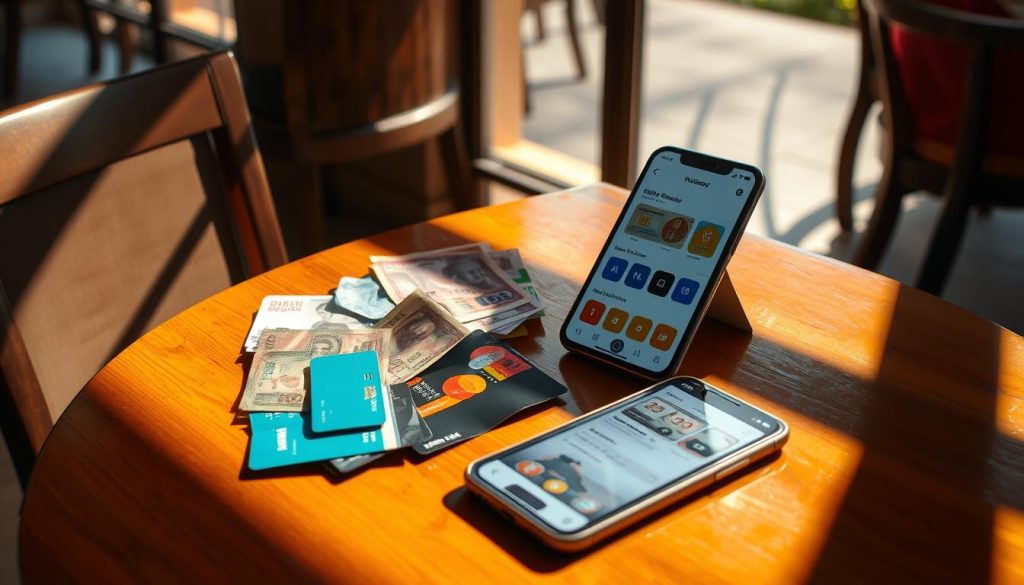
When to Use Cash vs. Cards
Cash is still widely used, especially in smaller shops and local markets. It’s practical for small purchases and ensures you’re covered where cards aren’t accepted. Always carry some cash for convenience.
Cards, on the other hand, are ideal for larger expenses like hotels or restaurants. They offer security and reduce the need to carry large amounts of money. Using a travel-friendly card can also save you on fees.
The Role of Banks in Secure Payments
Banks play a crucial role in providing secure access to your money. ATMs are widely available, allowing you to withdraw cash as needed. Always use ATMs affiliated with trusted banks to avoid extra charges.
Exchange services at banks often offer better rates than airports or hotels. Planning ahead ensures you get the best value for your money.
Benefits of Blending Payment Methods
Relying on just one payment method can leave you vulnerable. A mix of cash and cards ensures you’re prepared for any scenario. Here’s a quick comparison:
| Payment Method | Best For | Tips |
|---|---|---|
| Cash | Small vendors, local markets | Carry small denominations for convenience |
| Cards | Hotels, restaurants, larger purchases | Use travel-friendly cards to save on fees |
By blending both methods, you’ll enjoy flexibility and peace of mind. Always have a backup option in case one method isn’t accepted.
Planning your payment strategy ensures a stress-free experience. Whether you’re shopping in a market or dining at a hotel, the right mix of cash and cards will keep you covered.
Using Travel Debit and Credit Cards Effectively
Travel cards like Wise can simplify your financial experience abroad. They eliminate the hassle of carrying large amounts of cash and offer competitive exchange rates. Whether you’re dining at a restaurant or withdrawing money from an ATM, the right card can make all the difference.
How to Choose a Travel Card like Wise
When selecting a travel card, look for features like low foreign transaction fees and real-time currency conversion. Cards like Wise convert currency at the mid-market rate, saving you money on every purchase. They also allow free ATM withdrawals up to a certain limit, making them a cost-effective option.
Here’s what to consider:
- Low Fees: Avoid cards with high foreign transaction fees.
- Real-Time Conversion: Ensure the card uses the mid-market rate.
- ATM Access: Check for free or low-cost ATM withdrawals.
Avoiding Foreign Transaction Fees
Foreign transaction fees can add up quickly. To avoid them, choose a card that waives these charges. Visa and Mastercard are widely accepted and often come with travel-friendly features. Always read the fine print to understand any additional fees.
For example, the Wise card offers two free ATM withdrawals per month, with a small fee for additional transactions. This makes it a great option for frequent travelers.
| Feature | Regular Card | Travel Card (e.g., Wise) |
|---|---|---|
| Foreign Transaction Fees | 2-3% per transaction | 0% |
| Currency Conversion Rate | Marked up | Mid-market rate |
| ATM Withdrawal Fees | High | Low or free |
By choosing the right card, you can save money and enjoy a stress-free trip. Whether you’re using a debit or credit card, prioritize low fees and convenience.
Accessing ATMs and Local Banking Services
Accessing ATMs and banking services efficiently can save you time and money during your travels. Knowing where to find reliable options ensures you’re never left without funds. This guide will help you navigate the local banking landscape with ease.
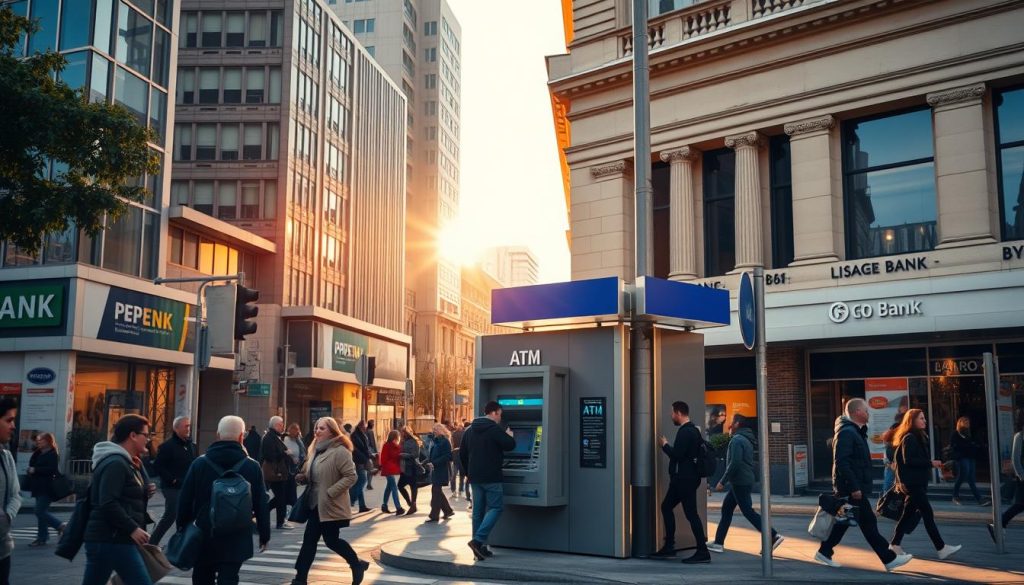
Finding Fee-Free ATM Withdrawals
Fee-free ATMs are available in major cities and tourist areas. Banks like Commercial Bank and Hatton National Bank often offer these services. Using these ATMs can help you avoid unnecessary charges and keep your travel budget intact.
When withdrawing cash, choose ATMs in well-populated areas. These locations are safer and more convenient. Always check for any signs of tampering before using the machine to ensure your security.
Typical withdrawal limits range from LKR 40,000 to LKR 80,000 per transaction. Some ATMs may charge a small fee after exceeding free limits. Planning your withdrawals can help you minimize these costs.
Differences Between Rural and Urban Banking
Banking services vary between rural and urban centers. In cities, ATMs are abundant and often offer multiple language options. In contrast, rural areas may have fewer machines, so it’s wise to plan ahead.
Before your trip, research local bank information. Knowing where to find ATMs and their operating hours can save you time. This preparation ensures you’re always prepared, no matter where your travels take you.
Tips for Safe and Secure ATM Use
Always verify the security of an ATM before use. Look for machines located inside bank branches or in well-lit areas. Avoid using ATMs that appear damaged or suspicious.
Understanding local banking practices enhances your overall travel experience. By planning ahead and choosing the right options, you can manage your finances with confidence and ease.
Sri Lanka: Ultimate Travelers Guide to Currencies & Payments
Managing your finances effectively while traveling can significantly enhance your experience. Understanding the local currency and how to handle it is crucial for a smooth trip. Here’s a recap of essential points to keep in mind.
First, always monitor exchange rates to get the best value for your money. The mid-market rate is your benchmark, and using reliable providers ensures you avoid unnecessary fees. Exchanging your currency before traveling often yields better rates.
- Carry a mix of cash and cards. Cash is essential for smaller vendors, while cards offer convenience for larger purchases.
- Use trusted exchange providers or banks to avoid hidden fees.
- Check for fee-free ATMs in urban areas to minimize withdrawal costs.
Being well-informed about local currency options makes your trip smoother and more enjoyable. For example, knowing the denominations of banknotes and coins can save you time during transactions.
Lastly, stay updated on exchange rates and banking policies, as they can change. Reviewing this guide regularly ensures you’re always prepared. With these tips, you’ll navigate your travels with confidence and ease.
Navigating Local Payment Systems and Mobile Wallets
Digital payments are transforming how people handle transactions in Sri Lanka. Mobile wallets and apps are gaining popularity, offering a convenient alternative to cash and cards. These options are especially useful in busy tourist areas where speed and efficiency matter.
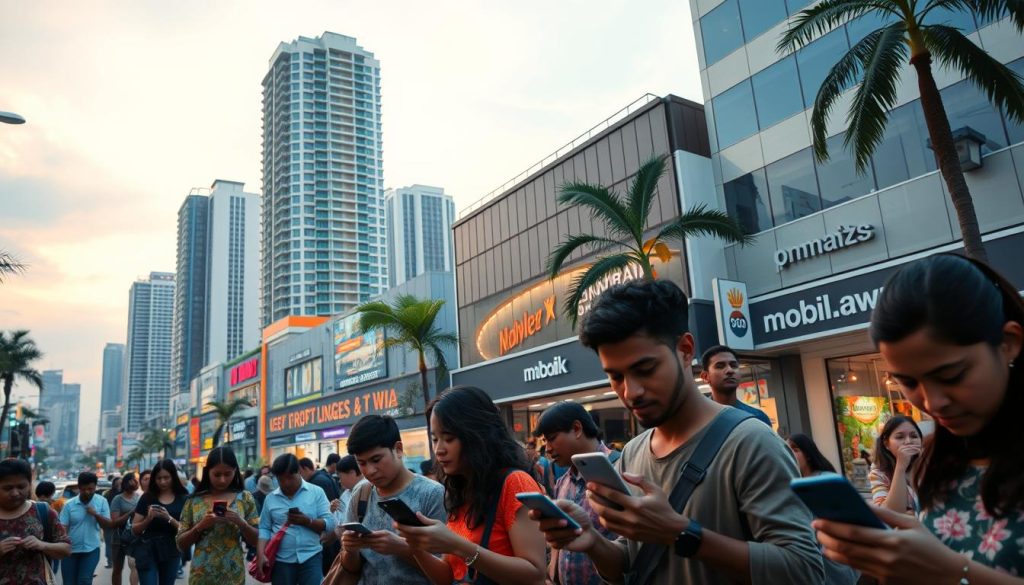
Apps like eZ Cash, mCash, FriMi, and Genie are widely used. They allow you to top up your phone, transfer money, and pay for services with just a few taps. These digital tools complement traditional methods, giving you more flexibility during your trip.
Explore Mobile Payments and Digital Wallet Options
Mobile wallets are designed for quick and secure transactions. They integrate seamlessly with travel cards, making it easy to manage your funds. For example, you can link your credit or debit card to a digital wallet for hassle-free payments.
Here’s how digital payments compare to conventional methods:
| Feature | Digital Payments | Traditional Methods |
|---|---|---|
| Speed | Instant | Slower (cash handling) |
| Security | Encrypted transactions | Risk of theft or loss |
| Ease of Use | Simple and intuitive | Requires physical cash or cards |
Setting up a mobile wallet is straightforward. Download the app, link your card, and follow the instructions. Most apps are available in English, making them user-friendly for travelers.
By embracing digital payment options, you can enjoy faster, safer, and more convenient transactions. Whether you’re shopping, dining, or exploring, these tools make managing your money easier than ever.
Cultural Etiquette and Tipping Practices
Understanding local tipping customs can greatly enhance your travel experience. Tipping is not just a gesture of appreciation but also a way to support local workers in the service industry. Knowing when and how much to tip ensures you respect local norms while staying within your budget.
Common Tipping Guidelines in Restaurants and Services
In restaurants, a tip of 10% of the bill is standard for good service. For exceptional service, you might consider tipping 15-20%. If a service charge is already included, an additional tip is optional but appreciated.
For hotel staff, tipping varies by role. Housekeeping staff typically receive 5-10 LKR per day, while porters may expect 1 LKR per bag. Concierge services often warrant a tip of 10-15 LKR for exceptional assistance.
Taxi drivers usually appreciate a tip of 10% of the fare, especially for longer journeys. For smaller amounts, rounding up to the nearest rupee is a common practice.
Why Cash Tips Are Preferred
In many cases, cash is the preferred method of tipping, especially for small vendors and casual services. Digital payments may not always reach the intended recipient directly. Cash ensures your tip goes to the person who provided the service.
For tourist areas, carrying small denominations of local currency is advisable. This makes it easier to tip without worrying about change or high costs associated with currency exchange.
Budgeting for Tips
Including tips in your travel budget prevents unexpected expenses. Allocate a daily amount for tipping based on your planned activities. For example, if you’re dining out frequently, set aside a portion of your daily budget for restaurant tips.
Adapting your tipping style to local customs ensures a smoother travel experience. Whether you’re in a bustling city or a quiet village, showing appreciation through tips fosters goodwill and supports the local economy.
Budgeting Your Trip with Currency Exchange in Mind
Planning your budget with currency exchange in mind can make your trip smoother and more cost-effective. Knowing the local costs and how to manage your money ensures you stay within your financial limits while enjoying your journey.
Estimating Daily Expenses in LKR
Start by breaking down your daily costs. For budget travelers, daily expenses can range from LKR 5,613 ($30) to LKR 15,067 ($80) for mid-range travelers. Luxury travelers may spend around LKR 45,793 ($245) per day. These estimates include accommodation, meals, transportation, and activities.
For example, a budget meal costs around LKR 1,838 ($10), while a mid-range restaurant meal might set you back LKR 4,727 ($25). Transportation costs vary, with a one-way local ticket costing LKR 50 ($0.15) and a taxi ride averaging LKR 100 ($0.30) per kilometer.
Combining Cash and Card Payments
Using a mix of cash and cards helps you manage your budget effectively. Cash is ideal for small vendors and local markets, while cards are convenient for larger purchases like hotels or restaurants. Travel-friendly debit or credit cards often offer better exchange rates and lower fees.
For instance, withdrawing cash from fee-free ATMs in urban areas can save you money. Always check the exchange rate before converting your currency to avoid hidden fees.
Adapting Your Budget for Different Areas
Costs can vary significantly between urban and rural areas. In cities, you’ll find more options for accommodations and dining, but prices may be higher. Rural areas often have fewer amenities but lower costs. Research local prices in advance to adjust your budget accordingly.
For example, a mid-range hotel in a city might cost LKR 7,386 ($39) per night, while rural accommodations could be cheaper. Knowing these differences helps you allocate your money wisely.
By planning ahead and staying informed, you can enjoy your trip without worrying about overspending. Keep track of exchange rates and local prices to make the most of your travel budget.
Conclusion
Exploring a new country becomes much easier when you’re prepared with the right financial tools. This guide has highlighted essential tips for managing your money during your trip, from understanding exchange rates to choosing the best payment methods. Being vigilant and planning ahead can save you time and ensure smoother transactions.
Remember to revisit these tips before your next travel adventure. Staying updated on local financial practices will help you adapt to any changes. Each option discussed—whether it’s using cash, cards, or digital wallets—is designed to make your experience safer and more convenient.
Take advantage of the practical advice shared here to enhance your journey. With the right knowledge, you’ll be well-equipped to handle any financial challenges while exploring this vibrant destination. Make sure to note these insights as you plan your next adventure in Sri Lanka.
The above is subject to change.
Check back often to TRAVEL.COM for the latest travel tips and deals.
